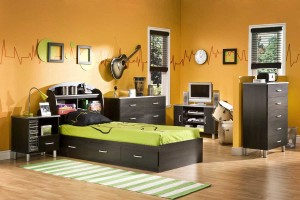
We’re going to continue our series on decorating with color by exploring how to maximize the impact of decorating with a variety of colors.
Certain colors may be chosen for a number of different reasons. Whether it’s your favorite color, it goes well with an anchor piece of furniture or you’re just looking to mix things up, there are certain things that can be done to take full advantage of the chosen color.
Red
Let’s start with red, a bold and dramatic color for interiors. It may take a bit of bravery to decorate with red, but it could turn out well if done properly.
It’s important to choose the correct red for your design scheme. Traditional design tends to work better with burgundies more-so than bright reds, which are well-suited for modern, contemporary styles. Country decor is best accented with softer tones of red.
Because of its bold nature, red works great as an accent color in black-and-white design schemes. Red is renowned for its ability to stimulate appetite, which makes it ideal for dining rooms and kitchens. If you’d prefer to dip your toes in the water before diving all the way in, try adding red elements into the room through accent pillows, vases or other similar items.
Green
Because of it’s versatility along with the number of tones and shades available, green is a popular color choice when decorating the home. Classic color combinations include green and brown, green and blue, green and pink, green and white and green and brown.
Green can practically be used anywhere in the home. It works well with natural colors like wood flooring and stone. It provides an organic feeling, which is why so many individuals enhance their homes with green houseplants.
When working with green color combinations, remember to experiment with brighter and paler shades of both colors in order to find a fit that matches your tastes.
Yellow
Incorporating bright, jubilant vibes into a room is made easier with tones of yellow. Be careful though, as yellow has a tendency to be difficult to work with. Start with muted tones of yellow to avoid being overwhelmed by the brightness of the original.
Smaller accent pieces are better suited for yellows because large-scale pieces can dominate the room and not allowing anything else to shine through. The quintessential yellow color combination is yellow and white with selective additions of black placed throughout.
